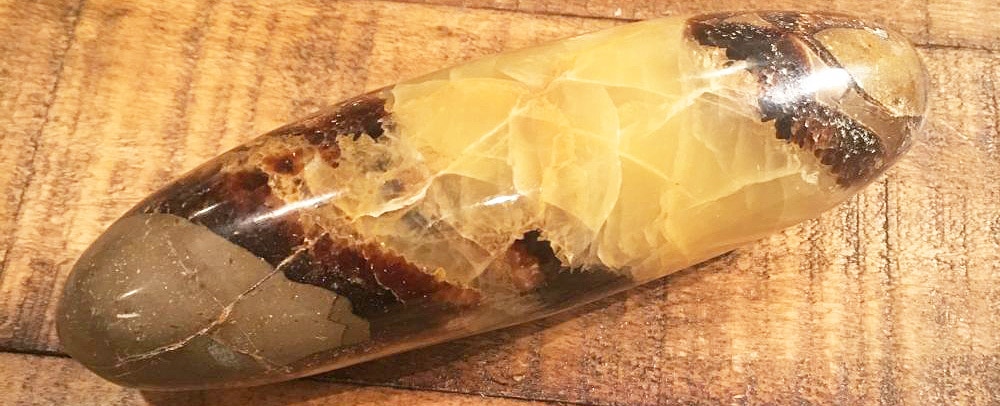Article Highlights
Welcome to the fascinating world of Septarian, a gemstone like no other! Imagine owning a piece of natural art so unique that no two specimens are identical. That’s the allure of Septarian, an extraordinary addition to the mineral world that captivates with its unusual shapes and shimmering, crystallized minerals. Also known by its evocative name, Dragonstone, Septarian is not just a stone; it’s a piece of Earth’s ancient history, a symphony of rock, mineral, and organic matter that tells a story millions of years in the making.
Why Septarian Stands Out
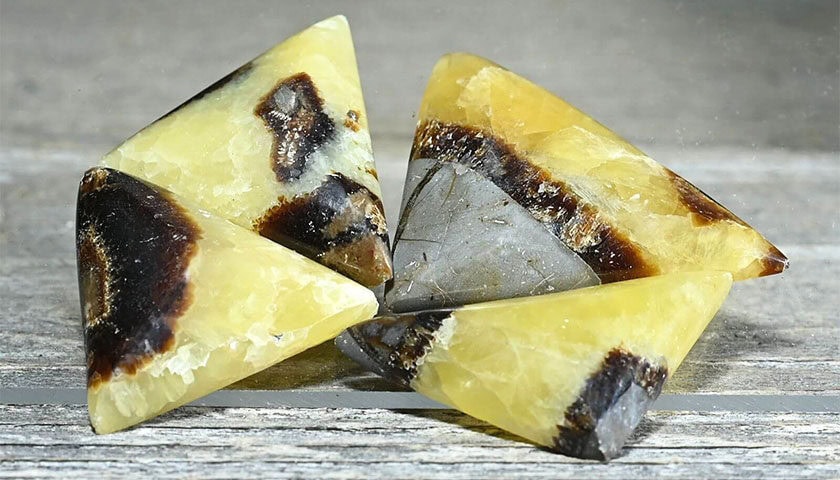
Septarian is a marvel of nature, formed from the intricate dance of geological processes. Picture this: nodules of Septarian forming in strange, wondrous shapes—pyramids, spheres, and more, each one a testament to the Earth’s creative power. These formations shimmer with a crystallized beauty that is both raw and refined, a testament to the timeless allure of the natural world. With Septarian, you don’t just own a mineral; you become the guardian of a piece of the planet’s soul, a curator of an artifact that is as old as time itself.
What is Septarian?
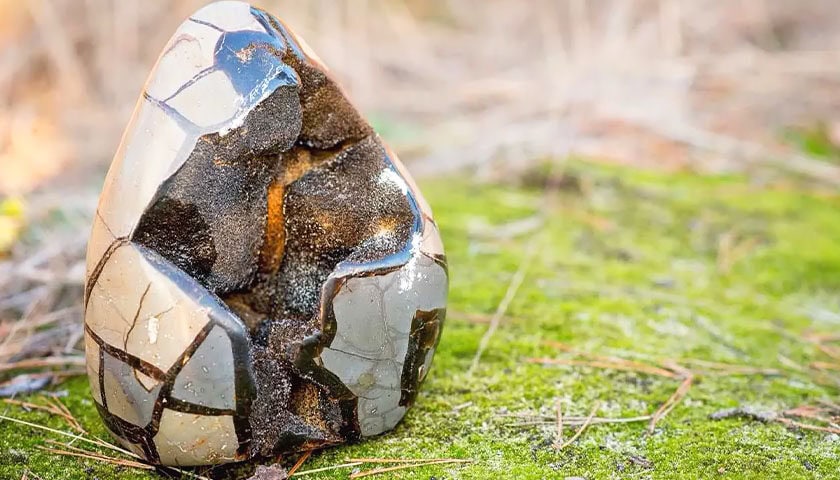
Dive deeper into the essence of Septarian, and you’ll find a treasure trove of wonders. This gemstone isn’t just a rock; it’s a confluence of elements and epochs, a blend of the earth’s very fabric. When you hold a piece of Septarian, you’re holding a snapshot of ancient oceans, volcanic eruptions, and millennia of geological choreography.
The Composition and Formation
Septarian is a geological masterpiece, a unique mix of rock, mineral, and organic matter. Its journey begins within layers of limestone sediment, where a delicate chemical ballet of moistening and drying effects plays out. In this hidden world, nodules start to form, sealing themselves from the empty spaces around them. This isn’t just science; it’s poetry written in the language of the earth, a tale of transformation and creation that results in something breathtakingly beautiful.
Types of Stones in Septarian
Within each piece of Septarian, a diverse cast of minerals comes together to tell a story of synergy and beauty. Here’s who’s taking the stage:
- Yellow Calcite: Radiant and warm, bringing a burst of sunshine and positivity.
- Brown Aragonite: Earthy and grounding, a reminder of the planet’s raw power.
- Grey Limestone: The foundation, solid and dependable, like the bedrock of the earth.
- White or Clear Barite: A touch of the ethereal, adding a hint of mystery and depth.
Each of these minerals plays a part in the Septarian symphony, contributing to its unique pattern, color, and energy. When you look at a piece of Septarian, you’re not just seeing a stone; you’re witnessing a natural collaboration of elements, a testament to the beauty that arises from diversity and cooperation.
The Story of Formation
The story of Septarian is as dramatic as it is ancient. Born from volcanic activity, these nodules are the product of mud and organic matter trapped and sealed by intense pressure and desiccation. This process isn’t just geological; it’s alchemical, transforming simple elements into a complex, captivating whole. The term “concretion” hints at this transformation, derived from “concrete,” it speaks to the solidity and permanence of these natural treasures. Holding a piece of Septarian, you’re holding a moment of transformation frozen in time, a tangible piece of the Earth’s endless creativity.
History of Septarian
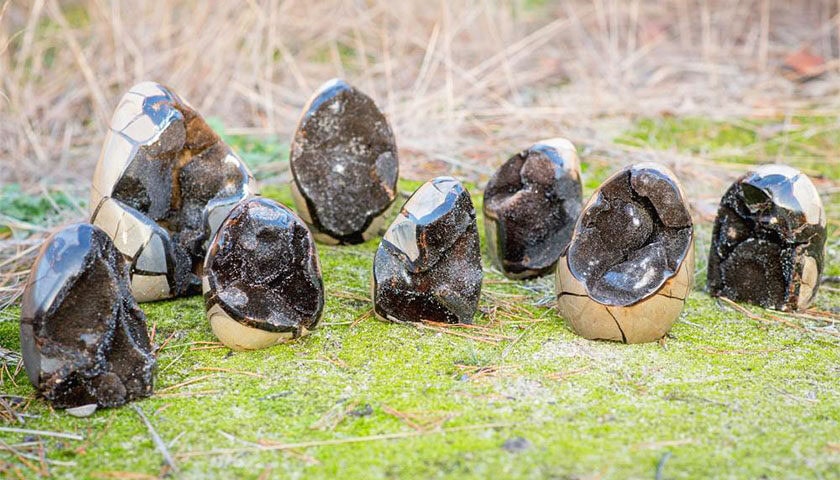
Venture into the annals of time, and you’ll find Septarian’s origin story, as intriguing and complex as the stone itself. This is no ordinary mineral; it’s a relic of an era when the Earth was a vastly different place. Discovering the history of Septarian is like peeling back the layers of time to reveal a world that existed long before humans walked the earth.
The Organic Connection
What makes Septarian concretions so captivating is not just their beauty but the incredible way they were formed. These are not mere stones; they are the product of ancient volcanic eruptions, the compression of Dead Sea creatures, and the relentless march of time. The organic matter within them whispers tales of a prehistoric world, connecting you to the distant past. As these nodules formed, they captured the essence of life and earth, creating a bond between you and the ancient world every time you touch them.
A Journey Through Time
Septarian nodules are chronicles of the Earth’s past, originating from the Cretaceous period, around 50 to 70 million years ago. This was a time of great change and upheaval, a time when dinosaurs roamed and then vanished. Each piece of Septarian is a time capsule, preserving the conditions and materials of an ancient world. Imagine holding a piece that formed at the same time the last dinosaurs gazed upon the skies. It’s not just a stone; it’s a piece of history, a fragment of a world long gone.
Septarian Specifics
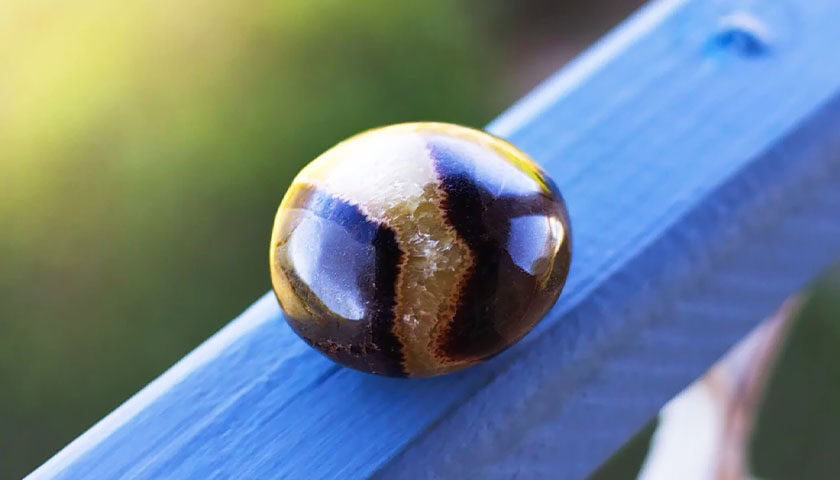
Delving into the specifics of Septarian reveals a world of intricate details and fascinating characteristics. This is where the true nature of Septarian comes to light, showing off its unique qualities and the incredible processes that created it.
The Name and Appearance
The term “Septarian” comes from the Latin word “septum,” meaning “partition.” This name is a direct reference to the distinctive, cracked appearance of Septarian nodules. These cracks aren’t flaws; they’re features, creating patterns and chambers that are as unique as a fingerprint. When you gaze upon the cracked surface of a Septarian, you’re not just seeing a pattern; you’re seeing the result of natural forces working in harmony, creating beauty from tension and pressure.
The Composition and Pattern
Septarian is more than just a stone; it’s a mosaic of minerals and elements. It typically measures anywhere from an inch to a foot across, sporting a rough exterior formed from thick chalcedony or crystalline silica. But it’s what’s inside that truly mesmerizes. The pattern of Septarian nodules is distinguished by cracks filled with Calcite, creating the yellow center, Argonite forming the brown lines, and Limestone making up the grey shell or exterior. This combination not only gives Septarian its distinctive look but also its character and personality. Each piece tells its own story, with colors and patterns that hint at its ancient origins and the incredible forces that shaped it.
What Distinguishes Septarian?

As we delve deeper into the world of Septarian, it becomes clear that this stone is not just another mineral. It’s a testament to the Earth’s artistic prowess, a showcase of natural beauty and complexity. Here, we explore what sets Septarian apart, making it a coveted piece for collectors and enthusiasts alike.
The Unique Exterior
Chalcedony or Crystalline Silica Exterior
One of the first things you’ll notice about Septarian is its remarkable exterior. Often formed from Chalcedony or Crystalline Silica, it provides a rough yet captivating outer shell. This isn’t just a protective layer; it’s a canvas displaying the Earth’s artistic touch. The exterior’s texture and composition are a prelude to the wonders hidden within, inviting you to explore further and discover the secrets it holds.
The Intricate Interior
Interior System of Polygonal Cracks
Within each Septarian nodule lies a world of geometric wonder. The interior system of polygonal cracks creates a network of lines and shapes, each telling its own story of formation and change. These cracks are not random; they are the result of natural processes working over millions of years, crafting a masterpiece that is as intricate as it is beautiful.
Prized Specimens form Hollow Geodes
Among the many forms that Septarian can take, the most prized specimens are those that form hollow geodes. These natural treasures are like secret chambers, revealing an inner world of crystals and patterns that dazzle and delight. Each hollow geode is a universe unto itself, offering a glimpse into the Earth’s creative potential and the mysterious beauty that lies beneath the surface.
Septarian Sculptures in Interior Design

Moving from the natural world into the realm of human creativity, Septarian finds a special place in the world of interior design. This section explores how these ancient stones can transform spaces and bring a touch of Earth’s magic into our homes.
The Earthly Aesthetic
Septarian sculptures are more than just decorative items; they are pieces of the Earth’s history that enhance the “down to Earth” feel of any room. Their natural organic tones and intriguing shapes make them perfect for adding a touch of nature’s artistry to your living space. Whether you’re looking to create a focal point or add a subtle hint of natural beauty, Septarian sculptures offer a unique solution.
Contrast and Appeal
The deep colors of Argonite mixed with the bright Yellow Calcite bring out a vibrant contrast that is both striking and harmonious. The organic and earthy tones of Septarian not only complement various design themes but also add a level of depth and intrigue to the space. Its unique aesthetic appeal lies in its ability to scream contrast while maintaining an elegant, natural look.
Shapes and Textures
Septarian can be found in an array of shapes and textures, from cubes and pyramids to roundish and oddish forms. Each shape brings a different energy and visual interest to the space, allowing for a personalized touch that reflects your style and the room’s ambiance. The varied textures of Septarian, rough and smooth, matte and shiny, further enhance its appeal, making it a versatile choice for different design schemes.
Where to Find Septarian Concretions

Embark on a global journey to discover where Septarian concretions are unearthed. These geological wonders are not bound to one location; they are scattered across the Earth, each site offering its unique version of this natural marvel.
Global Hotspots for Septarian
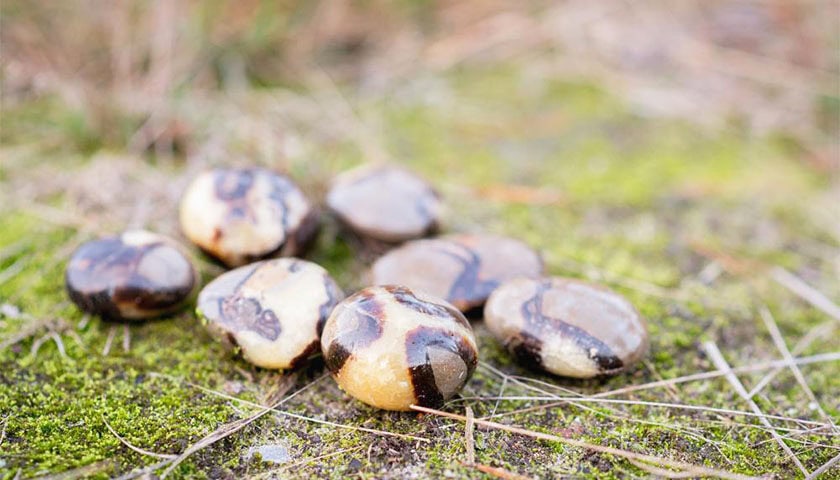
Septarian concretions can be found in various parts of the world, each offering a glimpse into the geological history of the region. From the sedimentary rocks of marine environments to the remote shores of ancient seas, these stones mark places where nature has worked its magic in exceptional ways. Some of the best-known localities for Septarian concretions include:
- The Moeraki Boulders in New Zealand
- The Isle of Wight and the Jurassic Coast in England
- The Smoky Hills region of Kansas, USA
- The Mancos Shale region of Utah and Colorado, USA
- The Bearpaw Shale region of Montana and Saskatchewan, Canada
Each of these sites offers a unique perspective on Septarian, showcasing variations in color, pattern, and size that reflect the local conditions and materials from which they formed.
Famous Septarian Concretions
Among the myriad of Septarian stones, some stand out for their size, beauty, or the stories they carry. These famous concretions are not just stones; they are legends, carved by time and the elements.
Spectacular Examples
Moeraki Boulders: New Zealand’s Giants
The Moeraki Boulders of New Zealand are perhaps the most spectacular examples of Septarian concretions. These giants, as much as 3 meters (9.8 feet) in diameter, are found eroding out of Paleocene mudstone along the coast near Moeraki, South Island. Composed of calcite-cemented mud with septarian veins of calcite, and sometimes quartz and ferrous dolomite, they are a natural wonder that draws visitors from around the world.
Koutu Boulders: The Beach Sentinels
Similar to the Moeraki Boulders are the “Koutu Boulders” scattered along the beach between Koutu and Kauwhare points along the south shore of Hokianga Harbour, North Island, New Zealand. These septarian concretions, also measuring up to 3 meters in diameter, stand as silent sentinels, bearing witness to the passing of time and the forces of nature.
More Typical Examples
Kimmeridge Clay Concretions: England’s Heritage
While the giants in New Zealand capture the imagination, more typical examples of septarian concretions are found in the Kimmeridge Clay exposed along the cliffs of the Wessex Coast of England. These smaller, yet equally fascinating, stones offer a more intimate look at the septarian phenomenon, allowing observers to ponder the intricate details and subtle beauty of these natural sculptures.
Meaning & Energy
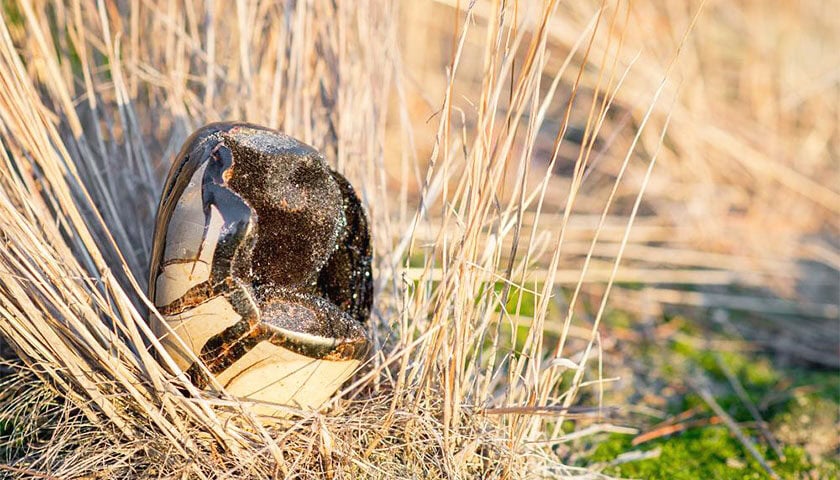
Embark on a spiritual journey with Septarian, a stone that is not only physically captivating but also rich in metaphysical properties. Septarian Nodule, with its deep connection to the Earth, offers a unique blend of energies that can transform your spiritual practice and personal growth.
Grounding Stone with Ancient Energy
Connection to Mother Earth
Septarian is a powerful grounding stone, known for awakening one’s deep connection to Mother Earth and the nurturing energy she provides. When you hold or meditate with Septarian, it’s as if you’re tapping into the planet’s core, feeling the warmth and strength that have sustained life for eons. This connection can help stabilize your energy, providing a sense of calm and rootedness in the present moment.
Activation of Root Chakra
As you work with Septarian, you may notice a profound activation of your root chakra. This energy center, located at the base of your spine, is your foundation, your connection to the physical world. By aligning and stimulating this chakra, Septarian helps channel vital life force throughout your body, enhancing your overall vitality and sense of well-being.
Emotional Healing and Protective Energy
Repairing the Emotional Body
Septarian is not just a stone for the physical realm; it’s a balm for the emotional body as well. For those going through significant changes or seeking to heal from past traumas, Septarian offers a protective shield of powerful earthen energy. This shield helps to heal wounds slowly from the inside out, providing support and comfort during the healing process.
Past Life Connection and Inner Awakening
This remarkable stone also serves as a key to unlocking past life memories and energies. Meditating with Septarian, particularly placing it over your third eye, can facilitate visions and insights into past life experiences. This deeper understanding can lead to profound personal revelations and a sense of inner awakening, driving drastic positive changes and replacing old habits with new, empowering ones.
Septarian Healing Properties

Dive into the healing world of Septarian, a stone that embodies the properties of its composite minerals. Each element within Septarian contributes to its overall therapeutic profile, making it a versatile and powerful tool for physical, emotional, and spiritual healing.
The Composite Minerals’ Healing Properties
Aragonite, Calcite, Limestone, and Barite
Septarian’s healing power is derived from the combined properties of Aragonite, Calcite, Limestone, and sometimes Barite. Aragonite brings stress relief and grounding; Calcite amplifies and clears energy while aiding memory; Limestone connects to the root chakra for grounding and nurturing; Barite, or Desert Rose, enhances intuition and clears blockages. Together, these minerals create a symphony of healing energies that can address a wide range of issues and imbalances.
Metaphysical Properties of Septarian
Grounding, Centering, and Earth Energy
Septarian’s most profound healing quality is its ability to ground and center its bearer. The strong Earth energy inherent in this stone reduces stress, anxiety, and anger, replacing these negative emotions with a sense of understanding and peace. By making you feel more connected to nature and the world around you, Septarian can help you feel lighter, happier, and more balanced.
Wisdom and Past Life Connection
Given its ancient origins, it’s no surprise that Septarian is considered a stone of wisdom. Many healers use it to connect with past lives and understand lessons that may have been lost over time. Whether through meditation or dreams, Septarian can help you access these deep reservoirs of knowledge, offering guidance and insight that is both ancient and profoundly relevant to your current life path.

